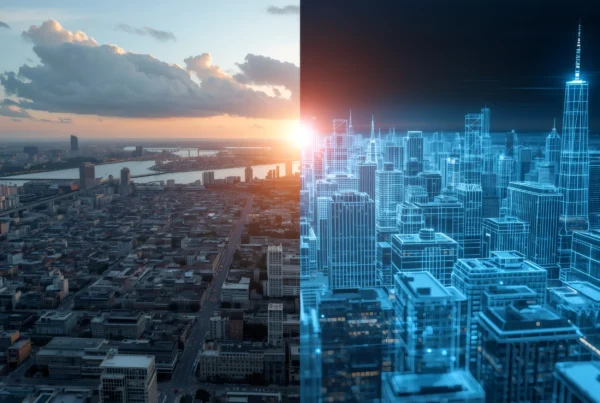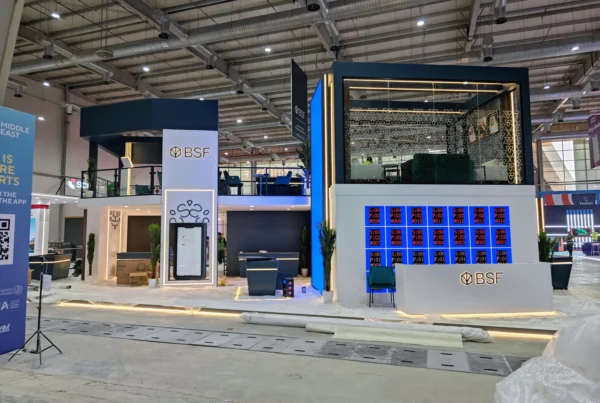Trade‑show floors are louder, brighter, and more data‑driven than ever, yet many stands still struggle to convert passing footfall into meaningful brand journeys. The difference between another forgettable “pop‑up” and a magnetic Immersive Booth is almost always process: a disciplined, end‑to‑end method that aligns goals, story, design, technology, build and onsite operations.
In this how‑to blueprint we share Chameleon Interactive’s framework for delivering fully integrated booth concepts—from the first brainstorming session to the final visitor handshake. You’ll see where audience insight meets spatial design, how interactive content and hardware are choreographed, and why a holistic approach consistently boosts dwell time, lead capture and post‑show ROI. We’ll also unpack a short case study from our Jeddah Central Development Company Digital Twin installation to illustrate the theory in action.
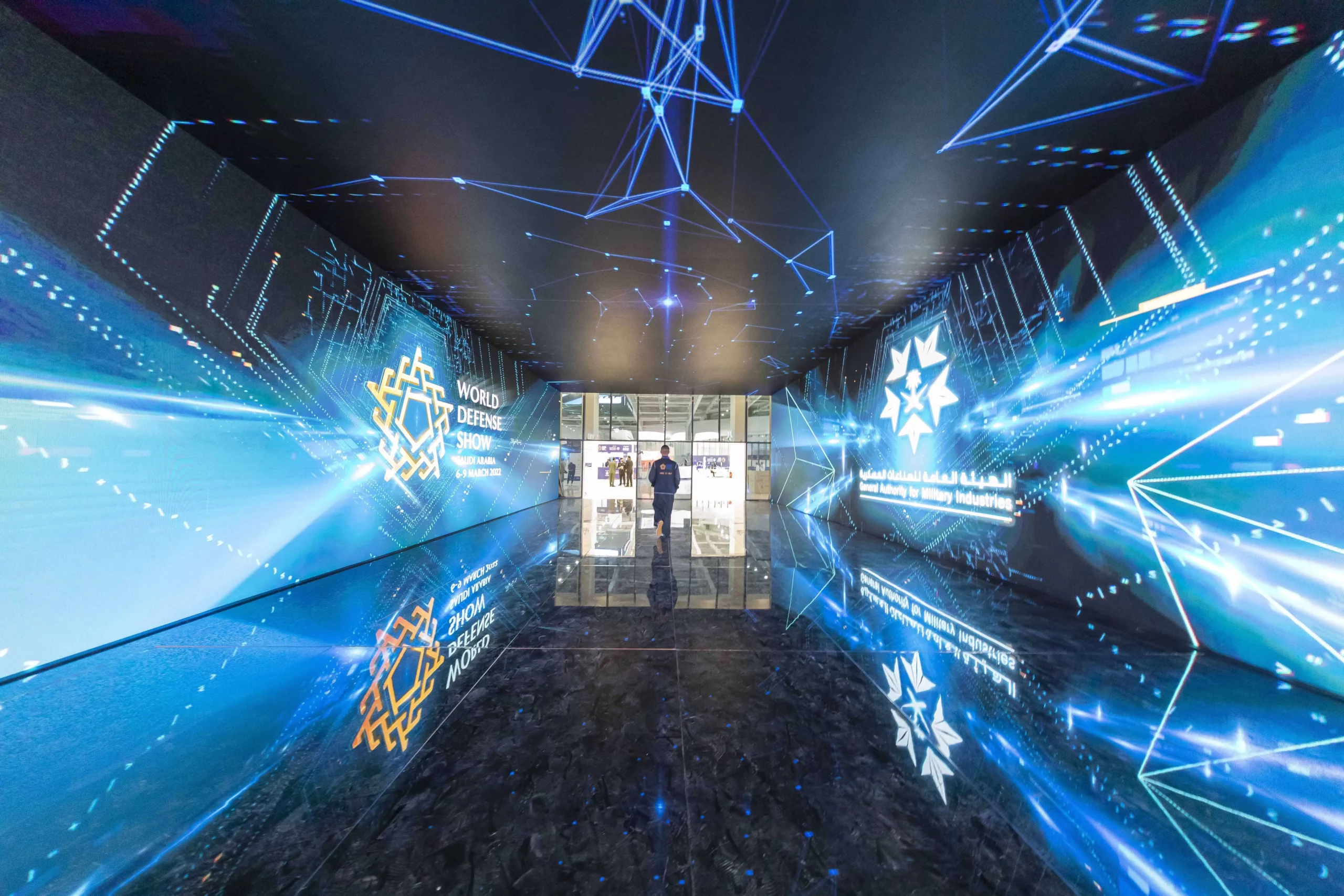
1. Begin With the End in Mind: Objectives, KPIs & Audience Profiles
Before you sketch a single wall or wire a single sensor, lock down three strategic pillars:
| Pillar | Key Questions | Typical Outputs |
|---|---|---|
| Business Objectives | What must the booth achieve for the brand? | Qualified leads, product demos, media buzz, partnership meetings |
| Audience Profiles | Who will visit? What motivates them? | Primary/secondary personas, pain points, desired emotional take‑away |
| Success Metrics | How will we know it worked? | Target dwell time, #demo completions, net promoter score, post‑show meetings |
Why it matters: exhibitors that define metrics up‑front track them on site, iterate faster, and report 33 % higher lead‑to‑deal conversion when dwell times exceed three minutes.
Pro tip: House your goals in a live “Booth Charter” shared by marketing, design, tech and fabrication partners.
2. Storyboard the Visitor Journey
Map Moments, Not Just Layouts
An Immersive Booth experience is a mini‑narrative with a clear beginning, middle and end:
-
Attract – Large‑format motion graphics, kinetic lighting or audio beacons pull visitors from the aisle.
-
Engage – Touch, gesture, AR or VR moments invite them to stay.
-
Convert – Staffed demo pods, meeting lounges or QR hand‑offs capture details and intent.
We diagram those moments in a “Journey Sequence” layer (similar to film storyboards) before we open 3‑D CAD. It guards against the common trap of designing beautiful structures that have no emotional arc.
Leverage Psychology of Flow
Open corners lower the subconscious “entry barrier,” while a central anchor experience (e.g., a floor‑to‑ceiling interactive LED map) acts as a social gravity well. Stands using strategic flow techniques see 40 % longer booth visits and up to 50 % more qualified leads.
3. Physical Design: Form Follows Story
Great architecture for an Immersive Booth balances theatricality with operational sanity.
-
Modularity – Lightweight aluminum frames and magnetic graphic panels speed installation and enable future re‑configs.
-
Height & Sightlines – LED portals or suspended halos give brand presence above the crowd without blocking sightlines to adjacent stands (an organizer requirement at most venues).
-
Materiality – Floor texture, acoustic baffles and edge‑lit acrylic can guide visitors subconsciously from discovery zones to deeper demo areas.
Compliance tip: Check local fire, rigging and accessibility codes early; retro‑fitting costs can swallow 15 % of budget.
Internal inspiration: Our Smart Interactive Solutions gallery shows multiple façade concepts that deliver impact while staying show‑floor compliant. Explore examples ›
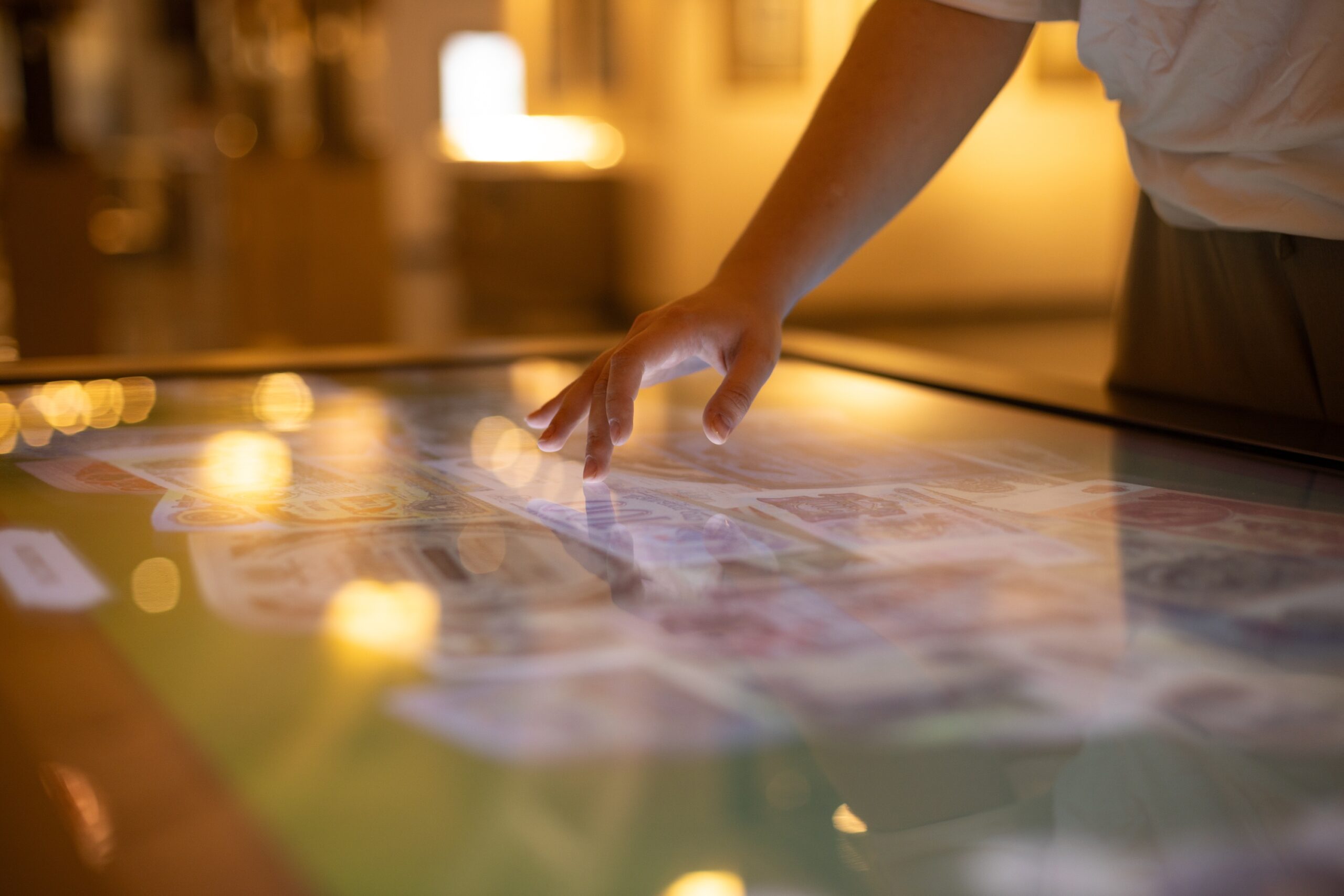
4. Interactive Content Design for Immersive Booth
Layered Engagement
| Layer | Typical Tools | Purpose |
|---|---|---|
| Curiosity (0‑5 s) | Motion graphics, large LED ticker, scent diffusers | Stop traffic |
| Exploration (5‑90 s) | Multi‑touch tables, object recognition plinths | Self‑directed discovery |
| Deep Dive (2‑10 min) | VR stations, AR product overlays, live demos | Educate & qualify |
| Commit (Post‑booth) | Personalized digital takeaway, meeting scheduler | Continue the story |
Interactive sessions like live polling or mini‑games increase dwell time and brand recall, according to Exposure Analytics.
Gamified screens alone can extend stay by up to 40 % compared with static displays.

5. Technology Stack: Choosing the Right Bricks
Core Categories
-
Display & Input – 4K touchscreens, LED walls, capacitive tables, gesture cameras.
-
Immersive Tech – VR headsets, AR tablets, mixed‑reality pass‑through lenses.
-
Sensing & Analytics – RFID wearables, LiDAR people counters, computer‑vision heat maps.
-
Infrastructure – Edge PCs or micro‑servers, locked Wi‑Fi SSIDs, PoE+ switches.
-
Control & CMS – Real‑time engine (Unity/Unreal) or no‑code platforms for rapid content edits.
VR, in particular, boosts user engagement by 27 % and holds attention 34 % longer than conventional displays, generating 33 % more leads.
And industry trend‑watchers agree: 2024‑2025 will see immersive tech become standard in trade‑show environments.
Integration note: We recommend a single “show hub” server to synchronize all endpoints: screens, lighting, sensors, so content, analytics and fail‑over are centralized.
6. Fabrication & Fit‑Out of Immersive Booth
Bridging Design and Build
-
Digital twins – We can create a full‑scale Unreal Engine model of the booth, enabling client walk‑throughs and clash‑tests before CNC machining.
-
Rapid prototyping – 3‑D‑printed bracket samples verify tolerances for embedded sensors.
-
Pre‑rig testing – All media players and LED controllers run a 48‑hour burn‑in at our warehouse to reduce onsite surprises.
Logistics Timeline (Sample 6 × 9 m Booth)
| Week | Milestone |
|---|---|
| ‑14 | Concept sign‑off & budget freeze |
| ‑10 | Structural engineering & BOM |
| ‑8 | Content alpha & tech procurement |
| ‑4 | Dry build & client acceptance |
| ‑2 | Crate pack & freight |
| 0 | Venue install (2‑3 days) |
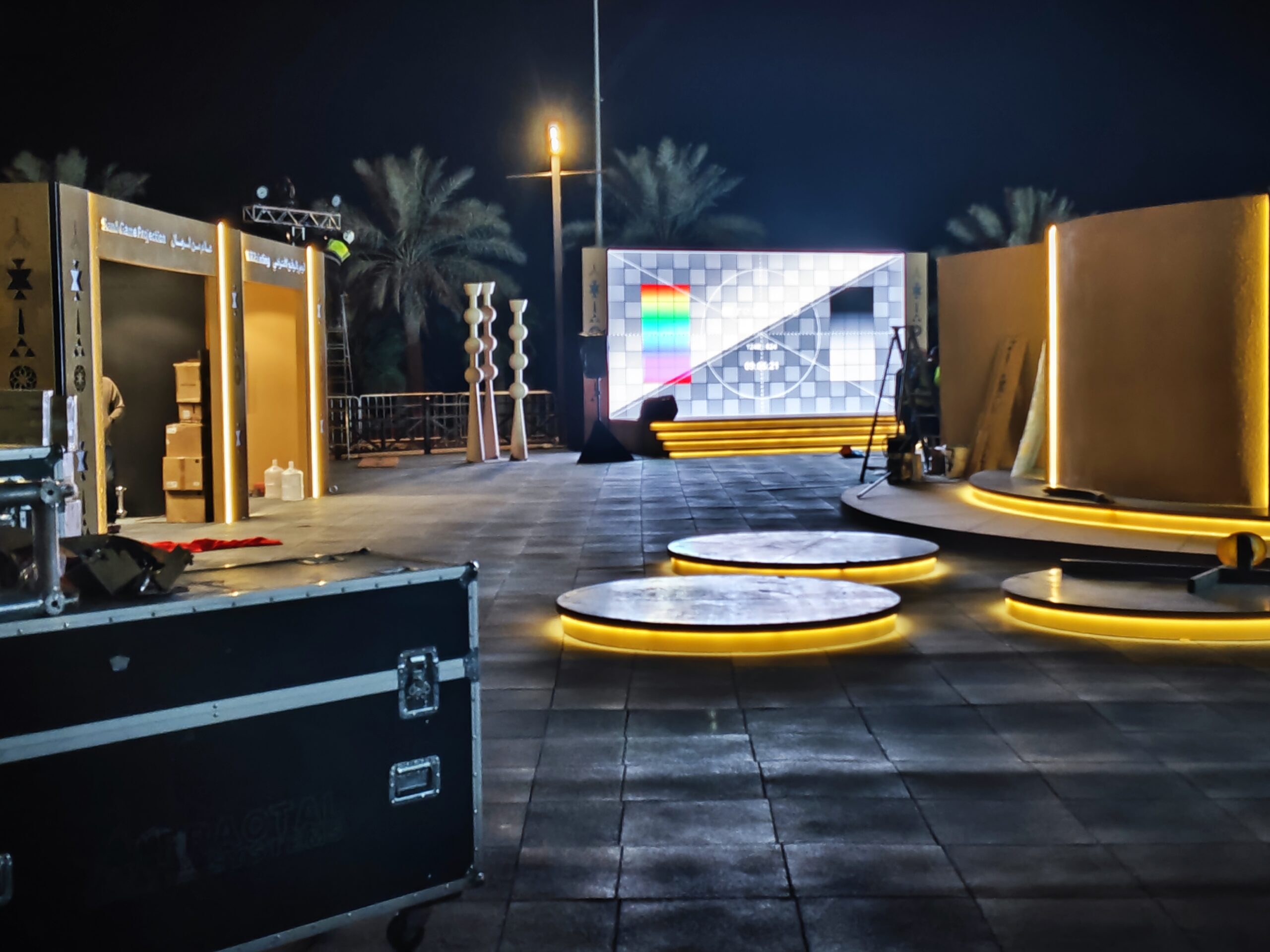
7. On‑Site Setup & Operations
An Immersive Booth only performs if the team behind it is equally prepared.
-
Install Playbook – CAD elevations, wiring diagrams, IP tables, and contingency checklists.
-
Staff Training – Role‑play scripts ensure brand ambassadors hand‑off visitors smoothly from interactive zones to sales staff.
-
Live Dashboards – Real‑time stats on dwell time, queue length and content hits allow mid‑show tweaks.
Data analytics is now “the new display,” with exhibitors leveraging heat maps and dwell dashboards to iterate in real time.
8. Measure, Learn, Improve
Five Metrics That Matter
-
Dwell Time – Longer stays correlate with a 33 % higher post‑show conversion rate.
-
Qualified Leads – Beyond badge scans: track job title, buying authority and timeline.
-
Engagement Rate per Activation – % of unique visitors who complete a VR demo, quiz or product wizard.
-
Social Amplification – Hashtag volume, UGC photo uploads, influencer mentions.
-
Return on Objective (ROO) – Custom scorecard combining above metrics against pre‑defined weights.
For deeper reading on event metrics, see Event Marketer’s Measurement Benchmarking Report.

9. Mini Case Study
JCDC Digital Twin Booth, Cityscape Global
| Snapshot | Detail |
|---|---|
| Footprint | 5 × 5 m island with wrap‑around 270° LED walls, touchscreen totem, VR pods |
| Goal | Showcase a 5.7 million m² mixed‑use development and capture investor leads |
| Signature Moment | Real‑time Digital Twin fly‑through synced across LED walls & VR headsets |
| Result Highlights | 2.8× average dwell time vs. previous year’s stand; 412 qualified leads in 4 days |
The secret sauce was tight integration: a single Unreal Engine build powered the hero fly‑through, the tablet‑driven 3‑D floor plans and the VR tour, ensuring consistent visuals and shared analytics. Explore the full project breakdown on our site: Jeddah Central Development Company Digital Twin ›.
10. Bringing It All Together The Immersive Booth as a Brand Journey
When objectives, story, design, tech and operations interlock, the booth stops being “real estate” and becomes narrative architecture. Visitors don’t just collect brochures; they live the brand promise through sight, sound and touch and your data proves it.
According to Cvent’s 2025 outlook, the average attendee spends 5.5 hours at a trade show, but their time is split among dozens of stands. Winning that share of attention demands an intentionally crafted Immersive Booth.
The holistic model delivers:
-
Higher Dwell – Open, experience‑rich layouts drive up to 40 % longer visits.
-
Better Engagement – Gamified and VR activations boost interaction by 25‑40 %.
-
Smarter Decisions – Real‑time analytics underpin agile tweaks and post‑show ROI reports.
Immersive Booth Experience – FAQ
What exactly is an “Immersive Booth,” and how is it different from a traditional trade‑show stand?
An Immersive Booth is a purpose‑built space where architecture, interactive technology, and narrative content are designed as one holistic system. Instead of passive graphics, visitors engage with touchscreens, VR/AR demos, responsive lighting, and real‑time data visualisations that turn the booth into a multi‑sensory brand journey.
Which planning steps must happen first to ensure success?
Start by locking down (1) clear business objectives, (2) detailed audience personas, and (3) measurable KPIs (e.g., dwell time, qualified leads). This “Booth Charter” guides every later decision on design, tech, and fabrication.
How do you storyboard the visitor journey?
Map the experience as a mini‑narrative: Attract → Engage → Convert. Identify signature moments (e.g., a floor‑to‑ceiling LED map) and arrange open sightlines that subconsciously draw guests deeper into the space.
What technologies deliver the most impact for engagement?
A balanced stack usually includes: large LED or projection canvases, 4K touch tables, VR or mixed‑reality stations for deep dives, and analytics sensors (RFID or computer vision) to capture dwell time and heat maps—all orchestrated by a central show‑control server.
How long does it take to design and build a mid‑sized (≈ 6 × 9 m) Immersive Booth?
Allow roughly 14 weeks from concept sign‑off to on‑site installation:
• ‑14 wks — Objectives & budget freeze
• ‑10 wks — Engineering & BOM
• ‑8 wks — Content alpha & hardware orders
• ‑4 wks — Warehouse dry‑build
• ‑2 wks — Freight
• Show week — 2‑3 days venue install
What measurable benefits can I expect?
Integrated, experience‑rich booths typically achieve 30‑40 % longer dwell times, 25‑40 % higher interaction rates on activations (e.g., VR demos) and up to 33 % better post‑show conversion compared with static stands.
Can Chameleon Interactive deliver everything end‑to‑end?
Yes. We handle concepting, storyboarding, interactive content production, hardware integration, booth fabrication, on‑site setup, and live analytics under one roof—ensuring a seamless brand experience and a single point of accountability. Explore our capabilities in Smart Interactive Solutions or reach out via our contact page to start scoping your next Immersive Booth.
Ready to Build Your Next Immersive Booth?
Chameleon Interactive delivers everything from concept to onsite operations under one roof, storytellers, 3‑D artists, software engineers, fabricators and show‑floor technicians.
-
Explore our Smart Interactive Solutions service lineup.
-
See more success stories on the Chameleon Blog.
-
Or contact us to start scoping your next wow‑factor stand.
